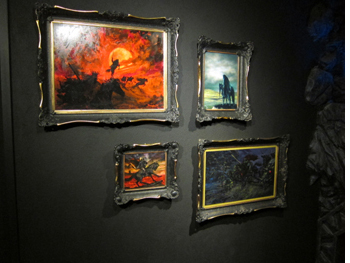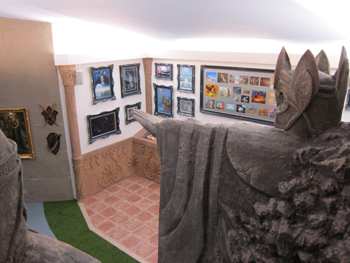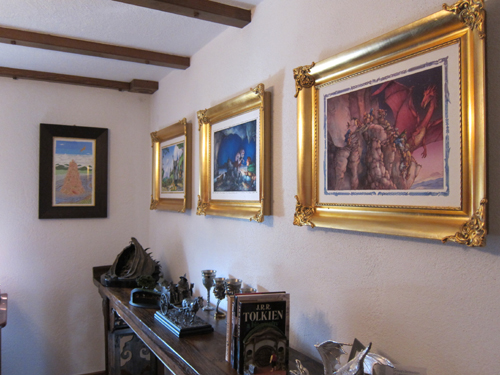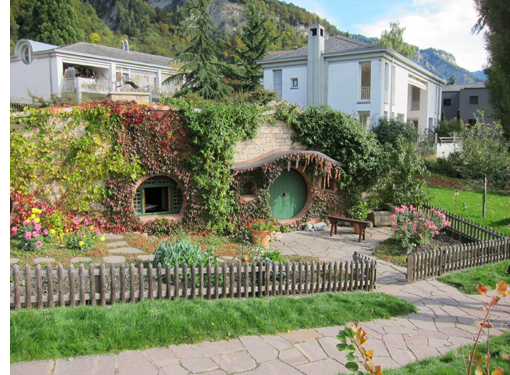 Recently I reported on the first Tolkien-based tour in the Swiss Alps, “In the Footsteps of Tolkien,” run by the Alpenwild company. I mentioned that our group ended the tour by visiting the brand-new Greisinger Museum, home to the world’s largest private collection of Tolkien art, books, and collectibles.
Recently I reported on the first Tolkien-based tour in the Swiss Alps, “In the Footsteps of Tolkien,” run by the Alpenwild company. I mentioned that our group ended the tour by visiting the brand-new Greisinger Museum, home to the world’s largest private collection of Tolkien art, books, and collectibles.
The image to the right shows the entrance to the museum, looking remarkably like the façade of Bag End transferred into a neighborhood in the prosperous eastern Swiss village of Jenins.
We had stayed the previous night in Chur, a charming small city with an old center with some buildings dating back to the medieval period, including a beautifully preserved cathedral. After a brief tour there, we took a short train ride to Landquart, the nearest station, and then took a taxi out to Jenins. As during the rest of our tour, the weather was sunny and mild.
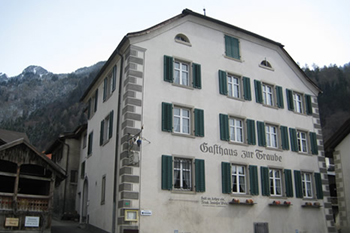 We arrived at the Gasthaus zur Traube,, built as a government toll house in 1832. There Bernd Greisinger, collector extraordinaire and president of the museum, and his charming father Wolfgang, Vice-President of the museum, met us. Sandy White and I already knew Bernd through the Hobbits Chat Room on FaceBook, so we immediately felt like old friends. We all had lunch at the Gasthaus, and luckily we were in Switzerland for the wild-game season. Most of us indulged in a lunch special involving venison, Spätzle, and red cabbage, which fortified us through the rest of the day and well into the evening.
We arrived at the Gasthaus zur Traube,, built as a government toll house in 1832. There Bernd Greisinger, collector extraordinaire and president of the museum, and his charming father Wolfgang, Vice-President of the museum, met us. Sandy White and I already knew Bernd through the Hobbits Chat Room on FaceBook, so we immediately felt like old friends. We all had lunch at the Gasthaus, and luckily we were in Switzerland for the wild-game season. Most of us indulged in a lunch special involving venison, Spätzle, and red cabbage, which fortified us through the rest of the day and well into the evening.
From there it was a short walk to the museum, where a number of other guests there for the afternoon tour in English, personally conducted by Bernd, were awaiting us in the garden outside “Bag End.”
Bernd is originally from Mainz, a city in the Frankfurt area in Germany, but he came to Jenins, as he puts it, because of the low taxes and high mountains. The tax situation in Germany would have prohibited such an ambitious project, but Switzerland was more welcoming. And the views in Jenins, while fairly far east, is still the Alpine regions I described and illustrated in my last entry, and the views all around are beautiful.
He bought the land for the museum and other buildings in 2005 and started building his house, adjacent to the current museum, in 2007. In 2008 he commenced work on the museum. As of 2013, he has only been collecting material for eight years, so the whole project had progressed in an impressively short time.
The Tour
Although the official opening celebration occurred on September 7, tours of the museum began on October 4. Our visit on October 19 was therefore only about two weeks later. Let’s get the statistics out of the way to start with. Bernd’s collection is constantly growing, but when we visited it included about 600 paintings, of which 207 were on display. Of the approximately 3500 books, something in the range of 30 to 40 were in cases to be seen by the public. The small portion of the books on display makes sense. These are some of the rarest items, including a unique Italian edition autographed by Tolkien. But the library is available to scholars and includes a vast array of Tolkien books, in English and in translation.
Beyond these basic holdings, there are numerous items on exhibit from the film collectibles, including Sideshow Weta busts, statues, and environments, as well as many facsimile weapons and jewelry. Some of these are rare prototypes.
The exterior of the modest entrance does not begin to suggest the size of the museum, which is, appropriately enough, 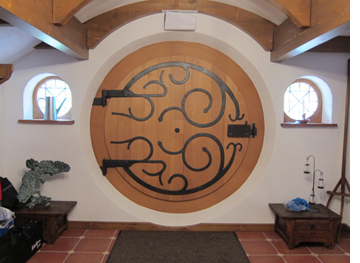 mostly underground. After stepping through the familiar round, green door, one finds oneself in a hallway modeled on the design of Bag End in the Peter Jackson films. All coats and bags are deposited there, and the front door (left) is locked behind the group. There are, as of now, at least, few labels on the paintings and cases of objects. The group sticks with the guide, and for security reasons a guard follows behind to make sure that no one falls behind. These are valuable objects after all. The artworks are not sealed behind glass but hung on the wall where one can examine them closely. In our case, Wolfgang brought up the rear, making sure that no stragglers fell behind. That’s he in the hallway at Bag End (below right).
mostly underground. After stepping through the familiar round, green door, one finds oneself in a hallway modeled on the design of Bag End in the Peter Jackson films. All coats and bags are deposited there, and the front door (left) is locked behind the group. There are, as of now, at least, few labels on the paintings and cases of objects. The group sticks with the guide, and for security reasons a guard follows behind to make sure that no one falls behind. These are valuable objects after all. The artworks are not sealed behind glass but hung on the wall where one can examine them closely. In our case, Wolfgang brought up the rear, making sure that no stragglers fell behind. That’s he in the hallway at Bag End (below right).
That room started off the tour on a high note. Tim Kirk’s famous painting of Gandalf visiting Bilbo at the beginning of 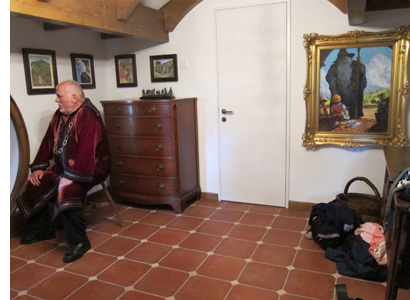 The Hobbit confronts the visitor upon first entering. It was one of the first paintings to grace one of the official calendars after the ones illustrated with Tolkien’s own artworks.
The Hobbit confronts the visitor upon first entering. It was one of the first paintings to grace one of the official calendars after the ones illustrated with Tolkien’s own artworks.
Probably my favorite artwork in the entire collection, though, is the small one to the left of Wolfgang’s head: Michael Hague’s final painting from The Hobbit: Gandalf is in the foreground, and Bilbo enters Hobbiton, with the Bag End auction going on in the distance at the top of The Hill. I would love to have a Hague original in my collection, but obviously they’re quite rare. Even Bernd, as far as I could tell, has only this one.
There are three rooms in the Bag End part of the museum. One contains an impressive array of the three original David Wenzel paintings for the three original issues of the Hobbit graphic novel, along with, “The Carrock,” one of several originals by Ruth Lacon scattered through the museum. (See the image at the bottom of this entry.)
After the Bag End rooms, the visitors wind through the underground area, arranged roughly by themes and areas of Middle-earth. There is the black-walled villains’ room, for example, with paintings of the Black Riders and sculptures of Orcs and Uruks (below left) . That room also contains an ominous throne where one can have one’s picture taken–at least for now. Soon the Witch-king in full armor with sword and Morgul-knife will occupy that throne.
Moving on, one passes through the Khazad-dum room, with large statues of the Balrog and Cave Troll. One then reaches a much brighter room dominated by statues of the Argonath. Here are displayed somewhat many paintings and illustrations depicting Lothlórien, and the River Anduin (below right). Ted Nasmith’s depiction of Galadriel and her Ring is here, as is Donato Giancola’s marvelously dynamic but simple depiction of a determined Gandalf’ about to battle the Balrog, which is depicted only by sparks flying in from out-of-frame left.
There’s an upper balcony to the Argonath room, the Rohan area, from which I took the photograph. There the signed Tolkien volumes are displayed.
And so the museum goes on, displaying artworks and collectibles in thematic rooms. There are too many to show here, but I hope each and every one of you gets the opportunity to make the pilgrimage to Jenins and visit this marvelous museum. You can book a place on a tour, with a choice of languages, here. Or if you wish to take the Alpenwild tour and get a more extensive look at Tolkien’s 1911 tour of the Alps, you will automatically end up at the museum.
My own main interest in visiting the museum was to see the many original paintings and drawings by Tolkien-inspired artists. I have a modest collection of such art myself. Nothing like Bernd’s, of course, but including some original Ted Nasmith paintings and drawings, one by the extraordinary Dutch painter Cor Blok, a wonderful study by Donato Giancola, and a marvelous napkin (!) with some John Howe sketches, including a dragon.
But I was interested in why Bernd, given his broad range of choices among artworks, had collected the particular ones that the collection currently contains. He was kind enough to explain by email.
Those Responsible
The museum has an art director, Davide Martini, which lives in Imola, Italy. Martini maintains contacts with the significant Tolkien artists around the world and apprises Bernd of possible buying opportunities.
There are definite criteria for deciding what to buy. First, there is the importance of the artists in the world of general or fantasy art.
Second comes the importance of the individual artwork. Has it been published? In order of importance, it could be that an image has been published in a book, a magazine, an official Tolkien calendar, somewhere else, or not published at all.
Third, obviously the asking price is significant. Purchases may be made from the artist directly, from an agent, auction, ebay seller, or whatever.
Fourth, if an artist offers several images, Bernd and his colleagues choose the ones which they think are the best by the artists and “then which could be shown in our rooms in a suitable position.”
Martini has obviously done an excellent job. The artworks in the museum cover a wide range of artists and illustrate scenes from the entire scope of The Hobbit and The Lord of the Rings. The Silmarillion is less well represented, with only about 20 paintings on display. The museum simply does not have enough space (so far, at least) to display the numerous Silmarillion artworks in the collection
(My own criteria for collecting are simpler. The image has to involve Gandalf, far and away my favorite character, and it has to conform at least vaguely with my idea of what he looks like and what the scene depicted looks like. And Gandalf can’t look like Ian McKellen. Ian does a fabulous job as Movie Gandalf, but he doesn’t look much like Book Gandalf.)
Bernd has other help with the museum. Ivan Cavini, the Creative Director (also Italian, from Dozza), designed the interior of the museum and built its “bigatures,” large models of such figures as the Argonath (glimpsed in the photo above right) and Smaug. A small environment of “Gollum’s Cave” is to be built starting at the end of this month.
Finally, Pieter Collier, familiar to many as proprietor of the Tolkien Library (Antwerp), is responsible for acquisitions for the library and also serves as webmaster.
The Greisinger Museum, which is a non-profit organization, will obviously continue to grow, both in terms of its collection and its display space.
Speaking of expansion, I’m sure all of us would have been eager to buy a catalog of the collection. Bernd assured us that such a book is in the works. In 2014, two versions of a catalog should appear: a small one that should satisfy most visitors, and a deluxe edition for the serious collector. I would be keen to acquire the deluxe version. I hope to report on that and other developments as the Greisinger Museum expands–with luck, a report based on a return visit.


